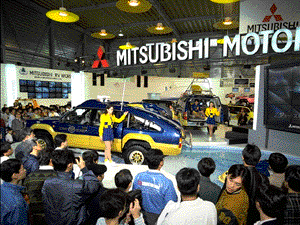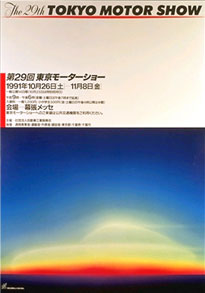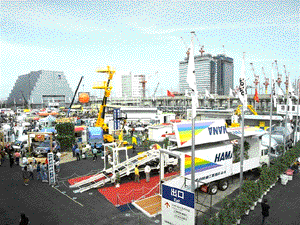 |
 |
 |
The
29th Tokyo Motor Show (1991
. 10/25 - 11/8)
 |
 |
| The 29th Tokyo Motor Show Poster |
"Discovering a New Relationship: People, Cars and Earth
as One"
The auto industry was facing a difficult year. Key words
describing business issues in the 1990s were: international
cooperation, environment, traffic safety and kyosei. These
problems became important for survival into the 21st century
as the environment surrounding the auto industry changed
dramatically.
International cooperation: Seven auto companies started
production in the U.S. to prevent the revival of Japan-U.S.
trade friction, restrain Japanese auto exports, and cooperate
in the revitalization of the U.S. economy. Their contribution
to the U.S. economy was shown by their production of 1.55
million vehicles and the employment of 30,000 people in
1991. However, friction did resurface again, because 1990
statistics showed automobile (including parts) exports
reaching 36% of total Japanese exports to the U.S. Hence,
the Japanese auto industry became the target of attack
by the U.S. Record-poor business prospects for GM, Ford
and Chrysler was also a reason. To avoid this friction,
Japan made efforts in line with Japan-U.S. discussions.
These were (1) expansion of parts imports (from $7 billion
in 1990 to $19 billion in 1994), (2) expansion of car
imports (with Japanese auto dealers cooperating in sell
in the cars), and (3) alleviation of imported car standards
and certification requirements.
|
 |
 |
 |
Environment: Global warming became the greatest problem
of human society, and automobiles came to bear part of
the responsibility. Japan s energy-saving technology set
the world standard. However, pursuit of higher economic
growth inevitably leads to increased energy consumption,
which, in turn, increases emissions of CO2 that are considered
to be the greatest cause of global warming. To reduce
CO2 emissions, development of energy-saving technology
and social systems (eliminating traffic congestion, etc.)
became all the more important. Automakers had to not only
clear pollution regulations, but work to maintain the
environment.
Traffic safety: Traffic accident victims in 1990 exceeded
10,000 line for third consecutive year, and vehicle safety
measures drew greater attention after the government declared
a "Traffic Accident Emergency." As more people became
concerned about "the second traffic war" and becoming
a "car-dependent society," criticisms of vehicles that
prevailed in the 1970s seemed to return.
Against this background, society s evaluation of companies
changed. "How it contributes to society" came to be regarded
as more important than "how much profit it makes." One
after another company set up community relations departments.
Changes in the auto industry environment began affecting
other businesses gradually. Domestic automobile sales
started to decline. As the Japan Automobile Manufacturers
Association, Inc. (JAMA) modified its demand forecast
to 7.67 million units, an annual decrease of 1.6% rather
than its original forecast of minus 1.0%, prospect were
very dull.
An unprecedented 352 companies, two governments and one
organization representing 13 countries participated in
the Show. Despite the unfavorable environment of recession
and sluggish auto sales, admissions totaled 2,018,500,an
all-time record. The Tokyo Motor Show marked the world
record for the second show in a row as far as admissions
were concerned. This may be partly owing to JMIF s efforts
to expand exhibition space and PR activities aimed at
attracting as many visitors as the previous show (1.92
million). Most amazing was the number of people who seek
fantasy through cars. Enthusiasm filled the show, and
must have given everyone confidence that Japan s future
motorization would be bright. There were many top managers
of American and European automakers visiting the show.
To name a few, Mr. Lloyd E. Reuss, President of GM, Mr.
Philip Bent, President of Ford, and Mr. Michael Farren,
U.S. Under Secretary of International Trade Administration.
From Europe Mr. Umberto Agnelli, Vice Chairman of Fiat,
Mr. Jacques Calvet, Chairman of the Peugeot Group, Mr.
Werner Niefer, President of Mercedes Benz, and so on.
Active inter-national exchange at the Tokyo Motor Show
was impressive. The gathering of world-renowned VIPs attracted
more press people from Japan and abroad than the previous
show. A total of 10,674 (35% more than the 28th show)
included 8,861 domestic (32% more) and 1,813 overseas
(52% more). All were record numbers. Particularly, this
show drew media from developing countries, which highlighted
the increased worldwide interest in the Tokyo Motor Show.
Amid calls for environmental protection and prevention
of traffic accidents, the auto industry got into high
gear to produce vehicles "friendly to the earth and man."
The salient characteristic of this show was competitive
display of technologies under development. The same trend
was seen in exhibitions by foreign automakers. For environmental
protection, efforts to reduce fuel consumption by existing
engines were seen, and new engines such as lean-burning
and twin-cycles came into bloom. However, the newest technology
of each company seemed to be directed to alternative energy
vehicles. Most conspicuous were: the TRI-X (Nissan) powered
by a gasoline-methanol mix; the Ryoma (Fuji Heavy Industries);
the HR-X (Mazda), a hydrogen-fueled rotary-engine car;
and solar cars (Toyota and Honda). Although they were
still only dream cars, the Mazda HR-X was said to be feasible
within this century and drew attention. Realized dream
cars were electric vehicles (EV). A prototype exhibited
by Tokyo Electric Power Co. could run 548 km on one charge.
Maximum speed was 176 km per hour, the best performance
in the world.
Including
the Nissan FEV, which achieved super-rapid charging in 1/5 the
time hitherto required, proposed solutions to EVs weak points,
such as short running distance, and long charging time, drew
the attention of media here and overseas. Foreign EVs included
the E1 by BMW, intended for practical use threeyears later;
the HX-3 by GM, which combined an electric motor and a gasoline
engine; a concept car by Mercedes Benz that sought to combine
performance with environmental consciousness; and a car with
an aluminum space frame by Ford. These displays gave a strong
impression that the development of environmental protection
technology would be an international issue into the 21st century.
Safety technology focused more on the development of hi-tech
apparatus to prevent accidents, rather than air bags to protect
passengers once they occurred. These included the AXV-III s
(Toyota) cruise control system, which automatically regulated
the distance between vehicles as well as speed; the TRI-X s
(Nissan) laser warning device that monitors distance between
vehicles; and the HSR-III s (Mitsubishi) automatic chasing and
decelerating function, operable by hand in emergencies. These
attracted the keen interest of viewers because they were attainable
with existing technology and would gradually be adopted in production
cars in the 21st century.
The high-class passenger cars and sports cars that had played
the leading role at the previous show disappeared, and "compact
cars" (exhibited for reference) with lighter, smaller bodies
and engines were placed on the turntables of each stand in line
with the show theme, environmental problems. Show cars included
the AXV-IV (Toyota), with a lean-burning engine mounted on a
450-kg aluminum/magnesium body; the EP-X (Honda), with a 620-kg
aluminum body;the ms 1000 (Mitsubishi) small rounded style;
the X-201 (Daihatsu), with a 700-kg FRP body that addressed
driving pleasure as well as environmental concerns; and the
compact sports DUAD (Nissan). These new types of cars were all
made with technology for protecting the environment and preventing
resource depletion, while also being designed to pursue driving
pleasure. They seemed to clearly present cars of the near future,
and were interesting. There were many commercial vehicles exhibited
for reference, which appealed for harmony between "environment,
man, and town." For instance, trucks were developed with an
eye toward soft design and friendly handling, wiping out the
image of danger and noise. For environmental protection, vehicles
using various alternative energy sources were developed. Most
popular were recreational vehicles (RVs), demand for which was
continually increasing to support people s outdoor inclinations.
Each company emphasized RV sales because of dull sales in other
areas. They competed fiercely with ever more dressed-up RVs,
considering the pleasure aspect in addition to drive ability
(4-wheel drive). Another corner attractive to youths was motorcycles.
Here too, high horsepower competition seen at previous shows
was absent. The mainstay were machines that suited the driver
and were enjoyable to look at. The change to a "soft mood" was,
according to one exhibitor, partly due to participation by middle-aged
drivers and women, and partly due to the spread of safety consciousness.
The overall impression of the show was a transition from "gorgeous"
to "sound or quiet" under the banner of environment and safety.
In such an atmosphere, the only thing that excited young people
was the Theme Hall, where European and American classic cars
and dream sports cars were on parade. This show indicated that
there were many enthusiasts who chased dreams although the times
demanded a vehicle society in which people were required to
take care of environment.
|
 |
|
|
|